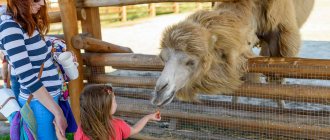Lately I have often been asked how to teach a child to pronounce the sound [l]? I think it's time to talk about this. The sound [l] is the next most difficult sound to pronounce after the sounds [p] and [p'], and learning to pronounce it correctly will require a lot of effort. Many people believe that a distorted [l] is hereditary and can no longer be corrected. There is a deal of truth in it.
I often see that many in the family strive to say [v] instead of [l]. I admit that this lambdacism, which is the scientific name for the distortion or absence of sound [l], also exists in my family. My dad and his brothers distorted [l], then I, and my daughter, and a cousin on this line also “vekali”. The distortion of one or more sounds by members of the same family only indicates that the child heard this sound incorrectly and saw with his own eyes the incorrect articulation. So I learned by imitation. When I started working as a speech therapist, I corrected my [v] to an intelligible [l] and also worked with my daughter. Now we are speaking purely. Yes, it is difficult and not fast, but it is possible! With the right approach and systematic training with a speech therapist and at home, you can learn to speak this beautiful [l] clearly and beautifully, and if necessary, then its soft version.
Propaedeutics
Before you begin correcting sound pronunciation, you need to collect the necessary information about the sound of interest. So, what do we know about the production of sound [l]? [L] is a sonorant sound, it is pronounced only with the participation of the voice, there is no noise.
Correct articulation when sounding [l] - the lips are stretched into a smile and change their position depending on the subsequent vowel. If it’s [y] or [o], it means the lips are pulled forward a little, if [s] – they stretch even more into a smile. The tip of the tongue becomes pointed and rises behind the upper teeth, while the middle part is lowered and the back part is raised. The lateral edges of the tongue are also lowered. So we don't see it, but the tongue in our mouth takes on the shape of a saddle. The vocal folds are also closed imperceptibly for us and vibrate slightly. The air stream passes along the sides, just in the place where the side edges of the tongue are lowered, and through the lips parted into a smile, the air, along with the sound, breaks out.
The pronunciation of the sound [l'] is different in that the lips are stretched even more to the sides, the tip of the tongue touches the front teeth, and its middle part is slightly raised, however, as when pronouncing any soft consonants. It is not for nothing that all soft consonants are also called palatalized (from the Latin palatum - middle palate), since during their production the middle part of the back of the tongue rises to the middle palate. Sometimes I still laugh, explaining to children and parents that in this case the tongue from the side resembles a tent.
Read also:
Causes and types of dyslalia
Learning to read correctly
Articulation gymnastics
Therefore, in order to correctly reproduce the sound [l], it is necessary to develop the tongue and lips. Articulation gymnastics will help us with this. [L] is the sound of the upper rise of the tongue, so I advise you to “warm up” the tongue from early childhood with such amusing exercises as “horse”. Simple clicking in a playful way trains the muscles of the tongue very well. Unfortunately, many children who come to me in first grade do not know how to make a “horse” at all. Therefore they do not have most of the top rise sounds. The tongue lies like a dead weight at the bottom of the oral cavity and cannot touch the palate without the help of the lower jaw, producing a characteristic clicking sound. Gradually, the kids and I begin to move the tongue as best we can. Already a month after such daily “twitching”, a full-fledged clicking sound and the correct “horse” emerge, that is, the movements of the tongue should be autonomous, while the lower jaw is motionless. I also recommend starting from the age of one year to practice such an upper lifting exercise as “tasty jam”, licking the upper and then the lower lip with the tip of the tongue, while simultaneously developing the orbicularis labii muscle.
So, what exercises do we need to make the sound [l]:
- "Smile";
- "Smile-pipe";
- "Shovel";
- "Delicious jam";
- "Hedgehog";
- "Swing";
- "Watch";
- “Let’s brush our teeth with our tongue”;
- "Painter";
- "Horse";
- "Fungus";
- "Turkey";
- "Sail";
- "Steamboat".
I would especially like to dwell on the last two exercises, they are aimed specifically at the correct pronunciation of [l].
"Sail"
– this exercise helps strengthen the muscles of the tongue, training its upper rise. The mouth is wide open, the tongue is straight (no need to wrap it in a roll), rises up and, touching the sharp tip with the upper alveoli, stands exactly behind the upper teeth, first on a count of 10, then from time to time increasing the “stand” by ten points, bringing up to 40.
"Steamboat"
– staged exercise for the sound [l]. Stick the flattened tongue out of the mouth, biting the tip with your teeth, spread your lips into a smile, pronounce for a long time: “Yyyyyyyyyyyyyyyyyyy”, which will smoothly move to “Yyyllllllllllll”.
Read also:
Speech disorders in children
Several ways to develop speech
Is it possible to practice making the sounds R and L without a speech therapist?
In the absence of other speech disorders, parents may well try to help their child cope with the difficult sounds R and L. In classes, it is important to adhere to the correct recommendations, consistency and regularity.
With due diligence - without overexertion and stress! - the result can be achieved without the help of a specialist. However, we note that if after one and a half to two months of regular classes, the child has not been able to “tame” complex sounds, you will still have to visit a speech therapist. The reason may be that you are not performing the necessary exercises correctly, or perhaps the child has some other speech disorders (for example, dysarthria, rhinolalia) that the parents were unable to identify on their own.
Types of lambdacism
Before moving on to sound production, you need to find out what type of violation of this sound pronunciation is.
| Labiolabial [l] | In this case, the lips are involved in sound production and instead of [l] we hear [u]: “uampa”, uapata, “ushka”, etc. |
| Labial-dental [l] | The production of sound involves the lips, which come into contact with the teeth and we hear [v], while the tongue does not rise behind the upper teeth, but remains lying in the middle of the oral cavity. We hear “vapa” - instead of “paw”, “votka” - instead of “boat”, “shva”, instead of “walked”, etc. |
| Reduced [l] | The case when [l] is replaced by short [th]. The tip of the tongue does not reach the upper teeth, but remains in the middle of the oral cavity, its middle back rises upward. As a result: “yapsha”, “yizhi”, “yuk”. |
| Interdental pronunciation | The tip of the tongue falls out between the teeth, this appearance is most consistent with correct articulation, while softening a little. |
| Softened pronunciation | This is when instead of a hard [l], we hear a soft [l]. In this case, the back of the tongue rises to the palate; this often occurs due to the fact that the tongue is in hypertonicity. The sound [l'] is most often replaced with [th]. |
Correction for lambdacism
The first stage
correction will definitely be articulation gymnastics. If you do the above exercises every day, you will see good results within a week.
Second phase
staged. Depends on the type of violation; if the pronunciation is interdental, reduced or softened, then a probe massage of the tongue is necessary. With interdental [l], a tightening massage is necessary, which will help the muscles hold the tongue behind the teeth. With a softened and reduced pronunciation, it is important to do a relaxing massage to eliminate hypertonicity of the tongue or, as I tell children, “to break the lump in the tongue”, which prevents the tongue from taking the shape of a saddle when pronouncing [l], tenses and, regardless of the child’s will, rises upward.
After a thorough massage and training exercises, we establish a routine: the lips are stretched into a smile, the tip of the tongue is between the teeth (this is how we start, then the tongue itself will “go” into the oral cavity), we press with our teeth on the protruding tongue so that the front part of it lifts up to the upper alveoli, and the middle part automatically sagged and we say: “llllllllly, lllllllly.” If at the same time we hear “oooooo,” then we help with our fingers, lowering the lower lip down. If we hear “vvvvvy”, then we move our lips to the side with our fingers. If a soft sound is still heard, then we ask the child to stick his tongue even further forward, biting the anterior-middle part of it. For interdental pronunciation, we ask the child to stick the tip of his tongue between his teeth, blow on it and hum. The result is a signal close to the sound [l]. We continue these pronunciation exercises until we hear a pure [l]. We constantly monitor the position of the lips; they can automatically stretch forward or the lower lip falls behind the upper teeth; and also behind the tongue: the wide tongue is extended between the teeth, we bite: “lllyyy”, “llllyyy”, “lllyyy”.
Often the production of the sound [l] comes from the vowel sounds [a], [u] or [s]. It is suggested to stretch the vowel, we are looking for the one that will suit your child, and we ask you to push the tip of the tongue between the teeth and bite in the middle, lips parted into a smile. Next, we move the tongue to the tooth position and ask the child to raise the narrow tip of the tongue to the upper alveoli. Control your lips!
Third stage –
automation of sound, if we heard the pure sound of an isolated [l], then we begin to practice it first in closed syllables: “al”, “ol”, “yl”, “il”, “ul”, etc. When we pronounce [l], we bite the tip of our tongue and part our lips into a smile, doing it slowly, methodically. Then we move on to automating open syllables: “la”, “ly”, “le”. The syllables “lo” and “lu” are a little difficult to automate, since the vowels [o] and [u] following [l] will require moving the lips forward, so we practice it sonically, first [l] - biting the tongue, spreading the lips, and then [ o] or [y].
Next comes the practice of sound in words
, starting with [l], then with the sound [l] at the end of the word, ending with [l] in the middle of the word. Then we move on to phrases, sentences and coherent speech. Exactly in this sequence. If a child has a persistent replacement of the sound [l] with some other sound - [v], [i], [d], [z] or [r], then work is still needed to differentiate the mixed sounds on specially selected speech material, as well as the development of phonemic hearing.
The sound [l'] is placed by imitation, that is, it is enough for the child to show where the tongue is - knocking behind the upper teeth and singing the song “la-la-la-la-la-la-la-la” (lips parted into a smile, necessarily )! Visually, the baby can remember the way of life; no mechanical assistance is required.
Pronunciation correction stage
[l] with systematic training at home and with a speech therapist, it can take from one to three months, this depends on the anatomical features of the structure of the child’s articulatory apparatus, his perseverance, motivation, desire to learn to speak correctly and, of course, on the parents who will skillfully motivate and encourage If successful, patiently monitor the correct articulation and clear pronunciation. Automating the sound [l'] usually takes less time. With proper methodical work, success will be guaranteed. Good luck!
Yulia Savelyeva
The feasibility of speech therapy classes
Some parents do not think about how to teach their child to say the letter L. They do not consider the defect to be something serious, but in adult life it will become the basis of complexes and worries.
Important! It is better to correct speech disorders in preschool age, then the process will take a little time.
Exercises for home practice on pronouncing the letter P for children
If parents do not know how to correctly teach their child to pronounce the letters L and R, then they should contact a specialist. A speech therapist will be able to correct this problem and develop the desired pronunciation.
How many lessons does it take to produce sound [l]
It is impossible to say with certainty how many lessons will be required to eliminate the defect. Sometimes sound production takes one session, in other situations it will take more than 30-40 meetings.
It all depends on the characteristics of the child, his motivation and the interest of the parents. Learning to pronounce the sound [l] is not so easy, since a preschooler gets used to a certain stereotype. Due to their age, it is still difficult for children to perceive learning activities.
How does an individual sound production lesson work [l]
The speech therapist performs sound production only after the student performs articulatory gymnastics well. The complex is performed strictly in front of a mirror. Afterwards they do breathing exercises and perform speech hearing tasks.
How does an individual lesson on sound automation work [l]
The speech therapist conducts individual lessons on automating the sound [l] only after calling an isolated pronunciation. At such lessons, the specialist develops the lexical and grammatical structure of speech, phonetic and phonemic hearing.
To do this, use different games and simulators. Modern speech therapists use computer games. Parents are required to participate in the process and carry out the specialist’s tasks at home.
Important! The duration of the lesson for preschool age is approximately 25 minutes. Physical minutes are required to switch activities.






